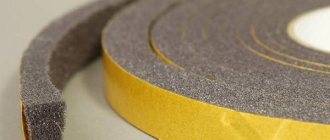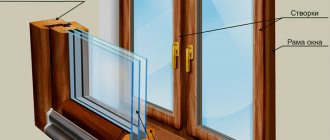Windows with wooden frames can create a healthy microclimate in the room, so many owners of apartments and private houses are in no hurry to replace them with metal-plastic. Over time, wood loses its tightness and begins to let in cold air and moisture. To eliminate this problem, you can use old materials - window tape, cotton wool, foam rubber, as well as use new technologies.
A wooden frame may lose its seal over time and will require insulation.
External insulation
Internal thermal insulation is often not enough. In order to additionally protect the window from moisture and precipitation, the slopes of plastic windows are insulated from the outside. For external work, as a rule, foam plastic or mini-slabs are purchased.
Foam plastic is easier to work with and you can finish it yourself without any special construction skills. There are ready-made slopes made of foam plastic that are very easy to install. When choosing a material, you need to take into account the features of the window. Typically, slabs with a thickness of no more than 2-3 cm are selected.
The insulation strips are coated with glue and attached to the mesh. The slabs are leveled using a level. After the glue has completely dried, it is necessary to cut and trim the strips. Then you need to once again coat the edges of the insulation with an adhesive solution and wrap the remaining reinforcing mesh. Next, we attach the corners to the slabs. After the glue has completely dried (approximately 24 hours), it is necessary to tighten the slabs with the solution again.
External insulation of slopes of plastic windows using ready-made foam thermal slopes is much easier, since all ready-made elements are available for sale: L-shaped strips, corners, etc. There is no need to prepare the surface for installation of the material, since they are attached to metal profiles .
Necessary materials
Before choosing an insulation method, you need to think not only about its purpose, but also the cost of the materials. Some of them can be found in any home:
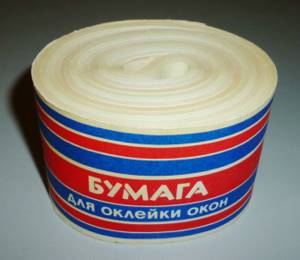
- Rubber seals. When a window or balcony door does not close tightly enough, this type of thermal insulation will save the situation. As a rule, this material is presented in the form of an adhesive strip attached to the grooves from the inside. In specialized stores you can find seals of different thicknesses, which will allow you to choose the best option.
- Cotton wool or foam rubber. This method has been known and used for many years. All you need to do is plug the cracks with these materials and seal them with strong tape. This will protect the apartment from drafts and wind. It is better to choose masking tape as adhesive tape. The advantage of this material is that it can be easily removed later without leaving any traces. This method can be used to insulate old windows.
- Putty. An old proven method that definitely won’t let anyone down. The apartment will really be much warmer. The downside is that when spring comes, you will have to spend a lot of time and effort to scrub and remove the grease.
- Paper. This method has also worked well. You just need to moisten white paper in water and hammer it into the cracks. A kind of paste is formed that will effectively fill all the gaps. Colored newspapers and other colored materials are not recommended. This can leave paint on the windows that is not easy to remove. There is no need to insulate the window.
- Silicone sealant. This is the highest quality and most durable material for window insulation. To do this you need silicone sealant and a special syringe gun. The work should be done very carefully, avoiding splashing of the composition. It is better to give preference to a transparent sealant: it will not be visible on the windows.
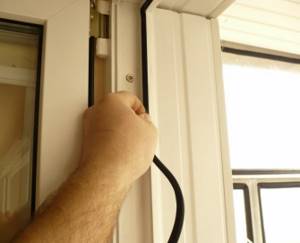
Another method of thermal insulation is glass insulation. This is a new method that will help maintain a comfortable temperature in the house. The material used is polyester, or more precisely, an energy-saving film based on it. For installation you will need film, scissors and a hair dryer.
How to seal windows to stop it from blowing
With the onset of cold weather, it is sometimes necessary to insulate window frames to prevent wind from entering the room. Various materials and methods are used for insulation. As practice shows, if the work is done correctly, the temperature in the room will increase by two to four degrees. In this article we will learn how to properly seal windows for the winter.
Preparatory stage
Before work, be sure to thoroughly rinse the surface of the windows, dry them and soak them in alcohol or gasoline to degrease them. Otherwise, adhesive insulation will not last long. Then dry the window frames again and begin the procedure.
Insulate before the cold weather sets in. This will not only ensure comfortable working conditions, but will also provide suitable humidity and provide the opportunity to immediately perform internal and external insulation. In addition, many materials cannot be worked with in the cold, since at low temperatures they lose their practical properties.
After insulation, the surface also needs to be washed or cleaned. How to clean windows after renovation, read here. And then we will consider various means of sealing windows.
Window putty
Paper or window putty is an affordable and quick method. To work you will need old newspapers or paper, water and two parts of crushed chalk or part of clay.
Grind the newspapers, mix the components and as a result you get a viscous, plastic mass that can be used to seal any, even the smallest and narrowest, cracks and gaps. For aesthetics, the putty is covered with decorative elements on top.
You can buy ready-made construction putty. This is a rather labor-intensive process, since before starting it is necessary to remove the old putty, then apply new material, level it, if necessary, close it with a bead and paint.
After the procedure, the window can be easily cleaned of putty. In addition, the product does not absorb moisture. However, the effect will only last for one season. In addition, the putty prevents the window frames from opening. Therefore, with the onset of warm weather, the product is removed and the windows are thoroughly washed. Before next winter, to prevent the wind, you will have to seal the frames again.
Scotch tape, cotton wool and foam rubber
Paper or masking tape is an old, proven and fastest option to eliminate drafts from plastic or wooden windows. It does not provide significant insulation, but the work is carried out quickly and the materials are cheap. Be prepared that in a strong draft such tape may come off.
If the apartment blows too much, use additional cotton wool or foam rubber. Seal large gaps between the sashes, between the sashes and the wall, or window sill with the material. The cotton wool or foam rubber is sealed on top using masking tape or special paper tape.
You can buy ready-made self-adhesive foam strips. This is an economical option to seal cracks on both wooden and plastic windows. Due to the adhesive base, you do not have to seal the material with tape, and the insulation will easily last throughout the season.
In this case, there is no need to work with water and liquids, which increases the convenience and practicality of the procedure. But sheathing with cotton wool or foam rubber and tape must be repeated before each cold season, since such products absorb moisture well, swell and no longer protect against drafts. In addition, a sealed window cannot be opened for ventilation.
Modern rubberized insulation
Modern Swedish technologies suggest using a special rubberized Eurostip seal. This is the most effective, durable and reliable, but also the most expensive method of insulation. It is easy and quick to insulate with such material. It does not absorb moisture and saves you from the cold even at minus forty degrees.
This seal comes in profiles of various thicknesses. “E” profiles are used to seal plastic windows. Profile “D” is denser and is used to cover cracks and crevices in wooden frames. Universal profiles “P” are suitable for both.
The profiles are not glued to the surface of the sashes, but are placed in a pre-prepared groove. There the material is securely fixed using a herringbone holder. At the same time, the appearance of the window remains aesthetic and attractive, and the window frames can be easily opened if necessary.
This design effectively protects from cold and retains heat in the room, and lasts for about twenty years. Among the disadvantages, we note the labor intensity and high cost of work. Setting up profiles on your own is quite difficult.
Heat-saving film
You can insulate metal-plastic windows using heat-saving film. It is transparent, completely encloses the glass, and transmits light. But for those who like to grow plants on the windowsill, it is worth considering that it blocks the ultraviolet radiation necessary for flower growth.

The film itself does not have warming properties; it retains the heat accumulated in the apartment. If the room is cold, the film will not make it warmer; the existing temperature will be maintained.
It is better to buy heat-saving film from well-known manufacturers; in the store it is a good idea to inquire about the availability of a certificate. High-quality film has the following properties:
- retains heat in the room;
- protects from prying eyes, since the windows are opaque on the outside;
- allows light into the room well.
Using cotton wool and tape
The main problem with wooden windows is the formation of cracks. They need to be periodically filled and sealed with something. Openings in the frames change the geometry of the window and sashes. Sometimes it’s enough just to adjust their position and tighten the fasteners. But usually they are sealed using:
- paper and cotton wool;
- sealant and putty;
- window tape.
To properly insulate a window with paper, you need to shred newspapers or used notebooks and soak them in water. The mass is taken out and squeezed out of excess liquid, mixed with clay and chalk powder in a ratio of 1:1:2, respectively. The mixture is immediately poured into the cracks, compacting it with a knife or ruler. Then you need to seal the sealed openings with tape or adhesive tape.

Windows can be properly insulated with paper mixture or cotton wool
Paper is difficult to remove, so sometimes it is replaced with cotton wool. The material is torn into small pieces and placed in the cracks, also covered with tape or strips of paper. In this way, you can insulate windows for one season, then the wool is compacted under the influence of moisture. It needs to be changed every year.
If the glass does not fit tightly to the frames, then you need to use sealant or putty. You can buy a special mixture in stores, although at home it is replaced with plasticine.
It is applied on the outside of the window between the frame and the glass. The material is pre-kneaded and lightly rubbed into the cracks. This insulation is enough for one season, since it melts under the influence of sunlight and cracks in severe frost. Transparent sealant must be applied to the glass groove, having first pulled it out. The material hardens quickly, you need to work with it carefully, as errors are difficult to correct.
How to properly glue insulation to windows - All about insulation and energy efficiency
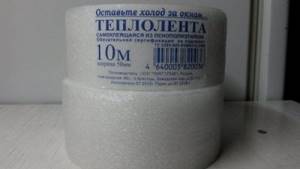
In houses and apartments where plastic windows have not yet replaced worn-out wooden frames, they prepare for the approaching frosts as if they were going to fight a serious opponent - after all, in winter, any crack becomes a source of constant drafts, simultaneously drawing heat out of the room. Even the best heating systems are not able to deal with such leaks and “heat the street”, so window covering has become a real autumn tradition. And only with the advent of thermal tape on the market, the situation noticeably changed for the better.
Until recently, various folk methods were used, such as wet newspaper twisted into a flagellum, rags for caulking cracks, foam rubber, paper strips on kefir, and the like.
A more advanced and convenient option is masking tape, or crepe, but, firstly, by itself it is not capable of providing the proper level of thermal insulation (the cracks still need to be additionally caulked or filled with insulation).
Secondly, the masking tape either does not hold well (if the room has high humidity - for example, in the kitchen), or holds so tightly that in the spring it has to be removed from the window frames along with the paint.
Thermal tape or thermal tape is a modern replacement for the usual masking tape, many times superior to it in its quality characteristics.
First of all, thermal tape is both an adhesive tape and an insulation material, that is, when sealing cracks with it, you do not need to take any additional measures, laying, caulking, and so on.
A standard strip width of 50 mm is enough to reliably seal a gap of up to 1 cm, but if the gap is larger, the thermal tape can be glued in two strips, overlapping.
Heat tape is not afraid of moisture and is resistant to chemically active substances, so it is used in any room, including in the kitchen, where ordinary masking tape (not to mention popular alternatives) begins to lose its properties soon after pasting due to high humidity. lag behind and let cold air into the room.
Moreover, the thermal tape can even be washed! In addition to thermal insulation, this material provides a certain degree of waterproofing of the room, and also increases its sound insulation. The adhesive composition applied on one side of the thermal tape, coupled with its elasticity, allows you to reliably attach the thermal tape to any materials (after cleaning them from contaminants, if necessary).
Sometimes a buyer has a reasonable question: how light, thin, translucent strips of thermal tape can serve as high-quality protection from Russian frosts. However, it must be taken into account that thermal tape is made from polyethylene foam, one of the most effective and environmentally friendly thermal insulation materials.
If we compare polyethylene foam with conventional insulators, then with a thickness of 1 cm, this material retains heat in the same way as 4.5 cm of wood or 15 cm of brickwork; mineral wool gives a similar effect with a thickness of 1.5 cm, expanded polystyrene - with a thickness of 1.2 cm.
In addition, thermal tape can be used in a wide range of temperatures: from -50°C to +70°C, the only condition is to carry out any work with it at a temperature of +1°C (for greater efficiency, temperatures from +10°C are recommended).
Thermal tape is confidently gaining popularity today and is quite capable of soon becoming a leader in its market segment, since useful qualities combined with an affordable price make it the optimal material option for protection from winter cold.
High quality putty
Another good sealant for insulating windows is window putty. This method of insulation was used a couple of decades ago. The putty is similar to hard, rigid plasticine, but if you squish it a little in your hands, it becomes more pliable, making it easy to apply into crevices.
How to seal windows from the cold in winter and from the sun in summer?
Are you here
With the onset of cold weather, people begin to fuss and insulate their homes as much as possible. Particular attention is paid to windows, since not all citizens have acquired plastic products yet, and they also try to seal them on all sides so that the frosty wind does not get inside. Moreover, many people know that it is through poorly sealed windows that up to half the heat from the apartment is lost. So how to seal the windows?
How can you seal windows for the winter?
Due to the increase in the cost of electricity and heat, people are beginning to actively cover their windows with everything they can get their hands on, just to reduce the likelihood of cold air entering the house in the winter.
Some use the proven “old-fashioned” method, using soap and paper, while others buy specialized glue intended for plastic windows - there are a lot of options. However, there is a modern method of insulation.
And if done correctly, then in cold weather you can raise the room temperature by 5 °C.
about the best way to seal windows for the winter
So that a person does not rack his brains about how to seal his windows for the winter, the industry has made for him the maximum number of possible options:
Paper method
The windows are sealed with paper, which is sold in the form of tapes. Any convenient adhesive base is used to carry out this process. For this you can take soap, flour mixture, kefir - whatever you can get your hands on. But this design in the form of a paper tape, unfortunately, does not retain its capabilities for long and eventually lets cold air into the house.
Window tape
Using masking tape to seal windows is the easiest, most economical and most effective way to insulate your home. If you can’t find it on sale, then ordinary household wide tape can successfully replace it. In addition, you will also need cotton wool and a hair dryer. It is used in drying ice.
If the place where the tape is attached is not properly dried, it will instantly peel off. It is better to buy non-sterile cotton wool. At home, the cotton wool is rolled into a bundle, and all the existing cracks in the windows are already clogged with it. If they are very narrow, then you can do without cotton wool. Tape is attached to a well-dried window.
The better you seal your windows for the winter, the more heat will be retained indoors.
Sticky foam
Another economical option is to use foam rubber on a sticky basis. There are a lot of such insulation in specialized supermarkets, and it is suitable for insulating wooden windows and plastic ones. The sticky foam base can keep the insulation on the window throughout the cold season. The only drawback is the high moisture permeability of the material, due to which its tightness may suffer in the process.
Silicone sealant
You can fill voids in windows with it, but this method is best used on old wooden structures. To do this, it is enough to remove the glazing beads, glue a thin layer of space between the glass and the frame, the cracks of the frame and the area between the window sill and the frame.
Rubberized seal
This is the most reliable and long-term option for covering windows in the winter. The only thing is that it will be more expensive in the price range. Before you begin the insulation process, you need to thoroughly wash and dry the surface so that it does not slip off.
These methods will help owners of any type of window increase heat conservation in the room.
How can you seal windows from the sun?
Everyone has a desire to escape the summer heat - some sit under the air conditioner, some douse themselves with cold water, and some eat ice cream. But in order to create an acceptable temperature in the house, without having an air conditioner, you can stick a film on the window so that the sun's rays cannot penetrate into the room.
You can see foil on some people's windows. The opinion that foil glued to the window will save you from the heat is wrong, since it is metallized, which means it only attracts the sun and heats the room more.
Sun protection film has two functions:
- From the side of the house it creates a pleasant shadow.
- From the street side it reflects the rays of the sun and the room, accordingly, becomes cooler.
In addition, in this way you can hide from prying eyes, if there are no curtains, and from the sultry sunlight.
How to apply solar film?
This can be done by anyone who does not have special skills in this type of activity. To do this job, you will need several tools:
- Detergent for window surfaces.
- Water sprayer.
- Plastic or rubber spatula (whichever is more convenient for you).
- A sharp knife for the job.
- Film for windows.
Advice! According to the established technological characteristics, the temperature at which the window gluing process will be carried out should not be lower than 7 °C. It is also strongly not recommended to install the film on the window on hot days, since at high temperatures the elasticity of the film begins to increase several times. This factor can affect the deformation of the material.
- First, you should thoroughly wash the window glass on both sides.
- Use a spray bottle to spray a homemade solution containing liquid soap and water onto the sticky surface of the film. It is better not to shake it too much, so that a lot of foam does not form. This solution will help the glass to move the product freely the way a person needs.
- Now you need to apply the film to the glass. After waiting for the foam to settle, use a spatula to smooth the film with gentle movements so that all formed bubbles are removed. Movements are carried out from the center to the edges of the film. Having achieved a perfectly smooth surface, you need to let the product dry.
- At the end, you can trim off the excess film when it is completely dry and set. It is better not to adjust the required size before gluing, as a small gap may form.
Before starting work, the window must be clean and dry. Only then will the film adhere well to the surface of the glass and last a long time. Now you don’t need to rack your brains and think about how to seal your windows from the sun.
How else can you seal the windows to prevent it from blowing? Old-fashioned methods
In addition to the above methods, you can give several more methods that answer the question of how to seal the windows to prevent it from blowing.
- You can take wet paper, fold it into a rope shape and fill the window cracks with it, and seal the top with an adhesive solution. However, in the spring you will have to work hard to somehow remove this insulation, since all this amateur work will dry out dead over the winter. Therefore, there is a possibility that the window frames will need to be repainted.
- A more gentle way of gluing windows against drafts is to use foam rubber as a rope, and on top you can seal it with ordinary fabric from old shirts or sheets. The strips should be 5cm wide. To stick them, you can use a soap solution. To do this, you can use any soap. Unlike paper, fabric does not tend to turn yellow, which will give the window an aesthetic appearance, and can be easily removed in the spring.
- You can also use another ancient method and seal the windows with paraffin taken from melted candles in a water bath at a temperature of 70 ° C. To implement the process, just take a regular disposable syringe, heat it up and, having filled it with paraffin, spray it into all the cracks that are in the windows.
- You can also use clothesline as insulation material. And if cold air leaks into the house from the glass part, then you just need to replace the outdated glazing beads with new ones.
What types of mounting tapes are there?
The types and functions differ from the place of use, the condition of the slope being processed, and the requirements placed on the mounted block. What materials are used?
- PSUL. This is a sealing tape suitable for any translucent structure. Helps wick away moisture. Made from elastic polyurethane foam, it comes in gray and black. On one side, an adhesive composition is applied to it. Sold in rolls, unwound in the required quantity during installation. It features excellent joint filling and expands after contact with air. Helps to obtain maximum insulation from moisture, as well as external influences.
It is relevant when sealing seams when installing doors and windows, it is used at the joints of small-sized moving parts of facades, it fills seams and gaps between the frame and the slope. To get an excellent result, you need to choose a tape that fits well in size.
- Water vapor barrier. The most popular during window installation. The advantages include the use of self-adhesive material, excellent fixation on the surface, eliminating the possibility of air or moisture entering the room, and the possibility of long-term use, despite exposure to ultraviolet rays. The material helps to eliminate installation gaps and seal structures made of plastic, wood, and concrete.
- GPL-S and insulated GPL. The structure is similar to the material described above. The main difference is that this tape is adhesive on both sides. Due to this, the scope of its application is expanding. Insulated ShPL tape is a more advanced option, made from high-quality polyethylene. Helps reduce heat loss at openings. It is characterized by high strength and is not afraid of mechanical damage.
- KVM (VM+). There are four types of this kind of tapes, which differ in the place of use. There are also differences in the adhesive composition of the material itself. It is quite common and can be used even in rooms with high humidity.
- Diffuse. Suitable for outdoor use. Often, when using such material, the fastening of the molding profile is insulated. Can be used all over the window. Eliminates the possibility of cold air entering the room and protects the polyurethane foam from exposure to ultraviolet radiation.
- Butyl rubber tape. Elastic, good adhesion, firmly fixed on different surfaces. Safe and environmentally friendly.
Don't forget that when working with any type of tape, there are some considerations during installation. What is the first thing you need to remember?
The opening must be carefully prepared for work. We are talking about cleaning it from contaminants. Initially, you need to install the block in test mode and perform markings. The window block is measured. The tape is applied gradually. The window is fixed in the opening using anchors and mounting plates. The tape is fixed only after the foam has polymerized. The choice of tape also depends on weather conditions
When working in winter, pay attention to ensure that the material does not undergo changes due to low temperatures.
Adhesive film
Thermal film for window insulation, adhesive directly to the glass itself, is practically invisible to others. In addition, there will be no glue stains left .
Manufacturers claim that this film works in a special way: it reflects ultraviolet and sunlight. Thanks to this, during severe cold weather the material slightly retains heat inside the room, and in summer it will prevent the house from overheating. Read also: heat-saving film for windows - purpose and do-it-yourself installation.
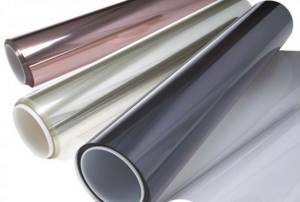
Sellers often lie when they claim that in the spring this material allows heat to pass through freely, but the energy of the spring sun is not enough to warm up the room well. And the manufacturers themselves warn about the rather low effectiveness of such a product: leakage will decrease by only 7%. This means that you are unlikely to have a strong effect on the room temperature. It is best to use this film as an additional tool.
In the spring, when the central heating is turned off, the room will not receive the required amount of heat. It will become damp and cold inside.
The installation instructions for heat-saving window film do not recommend using it to build greenhouses or greenhouses. This is explained very simply: almost all types of plants need to receive infrared and ultraviolet radiation for normal growth.
For this reason, using film on windows can have a very bad effect on all plants placed on the windowsill. This is a huge minus for all lovers of flowers and other flora.
Insulation with sealing tape
Plastic windows
Typically, plastic windows lose heat for two reasons:
- breakdown of fittings;
- seal wear.
Correct installation of the tape increases the insulating ability of the window. The following sequence of work is recommended:
before installation, the tape is kept at a positive temperature, since this affects its expansion inside the groove;
The tape is cut to fit the window. The joints are cut at right angles. For thermal expansion, a reserve is created: for every meter 1 centimeter of material;
The tape is pressed into the groove with a spatula, and the adhesive strips are removed in small sections.
Important!
1. In the corners of the frame, the tape is connected only end-to-end.
2. To prevent impregnation from leaking out, the tape is not compressed more than the permissible value.
After installing the sealing tape, the locking mechanism is adjusted: the pressure is changed by trunnions, which are located at the end of the sash.
Adjustment is made with a hex wrench. The pressure increases when the trunnion head is installed in a horizontal position.
Wooden windows
The Swedish method of insulating such windows using EuroStrip technology is in great demand. It has the following advantages:
there is no need for annual window insulation;
after ventilation, the tightness of the windows is not compromised;
frame service life increases;
high degree of protection from dust and street noise.
For insulation, two types of tapes are used: rubber and silicone.
By the way, branded Swedish silicone seals are easily inserted into the groove and last up to 20 years.
Installation is performed in the following sequence:
the sashes are removed from their hinges and inspected. Rotten areas are identified and then restored;
a groove is cut along the entire sash for the tape;
using a roller, the tape is pressed into the groove;
A rubber cord is placed inside the frame, and then the sashes are pulled together;
The window is hung on hinges and adjustable. If necessary, the hinges are rearranged and the fittings are changed.
So, both types of window insulation tapes deserve attention. Which one is better depends on the condition of the window.
If you choose the right one, the insulation will quickly pay for itself, and the apartment will always be warm and cozy.
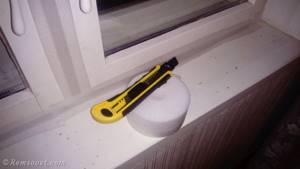
This short article will tell you how you can quickly and without significant costs insulate old wooden windows for the winter.
Personally, I encountered the problem of window insulation when I rented an apartment. In summer and early autumn the apartment was comfortable, but when severe frosts began, the old wooden windows began to feel cold. The main source of cold was the cracks at the bottom of the window - between the frame and the window sill.
The method that will be discussed below will help to cope with the problem temporarily, which is, in principle, suitable when the apartment is not yours or you are just planning renovations.
To insulate windows, we need a special material - thermal tape.
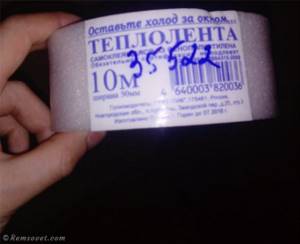
This is a very common and inexpensive material. The average retail price of a roll (length - 10 m, width 50 mm) is approximately 30 rubles. One roll is enough to insulate a standard kitchen window in a Khrushchev-era apartment building. That is, for a two-room apartment you will need 3-4 rolls, which in total will be 90-120 rubles.
The thermal tape is self-adhesive, that is, an adhesive composition is already applied to its surface, which is a big plus. It is also worth noting that the glued heat tape holds securely, but if necessary, it can be easily removed without damaging the paintwork or leaving marks. This material, useful for the home, is made of polyethylene foam, which has excellent thermal insulation properties.
It is recommended to carry out work on window insulation at temperatures above +10 o C, this will ensure reliable adhesion of the adhesive composition of the material to the surface of the window frame, slopes and window sill.
We take a roll of thermal tape and glue the window around the perimeter, as well as between the sashes.
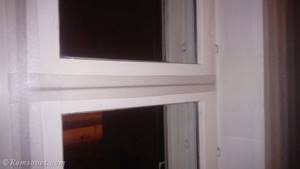
Smooth the glued area with your hand, cut off the excess with a construction knife or scissors. The entire process of insulating windows is very simple and takes a minimum of your time. Comfort and warmth to your home!
With the onset of cold weather, owners of apartments and houses have a problem in the form of window frames that allow a lot of heat to pass through. And if 5-10 years ago it was necessary to use old methods - from newspapers, cotton wool to strips of fabric, now you can find simple and effective materials on the market. One of these is window insulation that is self-adhesive. What it is and how to work with it can be found out below.
Reducing heat loss
If the heat leaves the room, and there are no cracks on the frame, then there are openings on the window sills and the inner surface of the slopes. Along with insulating windows, it is necessary to repair damaged parts .

Blowing foam into cracks can reduce heat loss
Before carrying out work, the window sill must be cleaned of old plaster and foam, and cotton wool, foam rubber or paper must be removed from the joint with the window. It is better to insulate it with polyurethane foam. To do this, the balloon is inserted into the gun and the material is blown into the slot. After hardening, the excess is removed with a stationery knife. The space between the wall and the frames along the slope is insulated with foam, then any type of insulation is laid. Plastic or drywall is installed on top, secured with tape for sealing windows for the winter or with masking tape. All joints are covered with a layer of sealant; after it hardens, the tapes are removed.
For those who are interested in how to cover windows for the winter to achieve maximum effect, it is better to choose plastic film. The material does not look very aesthetically pleasing, but it allows openings to be completely sealed. Remove irregularities on the film with a hairdryer.
Before the arrival of winter, wooden and plastic windows must be insulated. For this purpose, different materials are used, differing in efficiency and degree of complexity when carrying out the work.
What it is: description
The main materials from which insulation is made are rubber, PVC, foam rubber and polyethylene foam. An adhesive composition, protected with special paper, is applied to one side of the insulating tape. When applying insulation, the paper is removed.
Insulation materials are supplied in the form of cut strips, combined into reels, or in the form of formatted rolls.
Rubber
They are distinguished by the lowest price among analogues. They retain heat effectively and are attached using glue or a stapler. One of the disadvantages is poor resistance to moisture: when water gets on the rubber, the material quickly peels off.
If you buy rubber insulation, then the softest one. Rigid models do not adhere well to the window and allow heat to pass through.
Polyvinyl chloride
Reliable and environmentally friendly insulation, which has good frost resistance and resistance to deformation.
When choosing, it is important to pay attention to the rigidity of the product: overly hard models will not adhere well to the surface. Service life is 2-3 years
Foam rubber
Safe to use and reliable insulation. In addition to thermal insulation, they provide good protection from extraneous sounds. Foam insulation is supplied in the form of strips. The advantages of such seals include low cost and provision of air flow for the room.
However, in terms of thermal insulation, foam rubber is significantly inferior to PVC and polyethylene foam, plus it peels off from the surface quite quickly.
Figure: the shelf life of foam rubber is 1-2 years.
Polyethylene foam
They are bundles made of foamed polyethylene. They retain heat perfectly, provide sound insulation and even protect against moisture on the balcony. The most expensive insulation materials among those presented. Service life – 3-5 years.
Benefits and Features
The advantages and technical characteristics of self-adhesive insulation include:
- Frost resistance. Depending on the material from which the insulation is made, its thermal conductivity coefficient varies. However, for all of them it is at a high level: after application, the tape will maximally limit the contact of the room with the environment and prevent the appearance of drafts and cold bridges.
- Versatility. The insulation is suitable for cracks up to 7 mm wide.
- Reliability. The material is not afraid of temperature changes, moisture, and chemical influences.
- High-quality sound insulation. Most types of insulation can not only protect the room from frost, but also from extraneous sounds.
- Environmentally friendly. The materials do not come into contact with the environment or react with chemicals. Insulation materials are absolutely safe for human health.
- Convenience. Once applied, the insulation will not interfere with closing and opening windows. And the installation process itself will not require the help of specialists: the owner of the house will be able to insulate the window on his own.
- Low cost. Compared to other methods, self-adhesive insulation has an optimal combination of price and quality.
- Variety of colors. Among them are white, black, dark brown, which allows you to choose the material to match the windows, ensuring a harmonious appearance of the finished structure.
- Fire safety. The materials from which insulation is made are low-flammable and difficult to ignite.
The video shows self-adhesive foam insulation for windows:
One of the disadvantages of insulation is its fragility - the material is enough for one or two seasons. And also that the tape is not suitable for insulating plastic windows or loggias with double-glazed windows.
But this article will help you understand how to use foam insulation for windows and how to do it correctly.
But what self-adhesive insulation for metal doors is and how it is used correctly can be understood by watching the video in this article.
Types of thermal film
In more severe climates, the film greatly improves heating efficiency. There are two main types , specially designed for insulating buildings: the first type is glued directly to the surface of the windows, and the second is attached to the window strips. The latter are considered much more effective, although they do not have a very good effect on the appearance of the window.
A high-quality double-glazed window does not require any additional work. It perfectly protects the room from the cold, so the film is used only in those buildings where the quality of window installation leaves much to be desired or where insulation is carried out based on the climatic characteristics of the region.
Installation of thermal film is usually not carried out in houses with double-glazed windows located in the temperate zone or in the south.
Below is a video from which you can learn about all the pros and cons of insulating window blocks with thermal film:
Installation of double doors
A good way to insulate your home is to install a double entry door. Due to the formation of an air space separating the room from the street, heat is retained. The disadvantage of this design is the reduction in space.
A threshold is set for the indoor unit. Insulation is additionally laid on the slopes between the doors. There are designs where two doors are hinged on one deep frame.
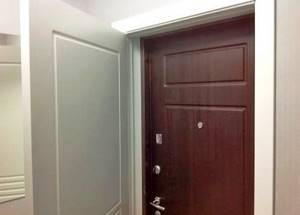
When insulating entrance doors, you must remember that moisture affects the canvas from the street side. Treatment with impregnation, painting with paint or varnish will help protect against dampness as much as possible. Drying oil creates good waterproofing.
There are a number of rules by which entrance and interior doors are installed. When installing them in accordance with GOST, there are many options for how to seal the gap, which must be present. The gap ensures unhindered opening and closing of the canvas, even if it swells or is slightly distorted.
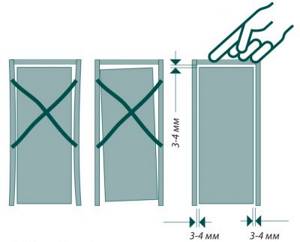
Clearance standards for a standard door
Insulation with cotton wool and foam rubber
An inexpensive and simple way to insulate is to seal cracks with industrial wool. It has good thermal insulation properties, is easy to install and remove when the weather gets hot. The cotton wool is placed by hand, pushing it inside with a spatula or screwdriver. Fabric tape is glued on top to avoid marks when removing, since paper always leaves stains that are difficult to wash off.

In old wooden windows, the sashes dry out greatly, forming large cracks. It is easy to cover them with foam tapes. Self-adhesive tapes are available for sale that easily adhere to the sash. Ordinary foam rubber is secured with nails. Fabric or paper is glued on top.
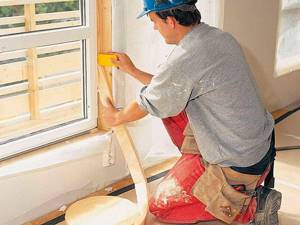
What is PSUL and how is it produced?
PSUL is always considered as a pre-compressed sealing tape. The self-expanding tape itself consists entirely of an elastic polyurethane foam mass, which is completely impregnated with a special solution that prolongs the service life of the sealant - a mixture of modified acrylic.
Each manufacturer has its own individual method of producing heat tape, however, there are several basic similar steps:
- polyurethane foam, which belongs to the class of gas-filled plastics, is the basis of the strip;
- the prepared base is impregnated with an acrylic solution or other components;
- Excess solution is removed, then the existing material is sent to the drying chamber, where the layers of the tape structure are connected;
After drying, the product is treated with an adhesive component, a binding material is applied - reinforced mesh, as well as an outer paper layer. Once the production process is complete, the tape is twisted and then compressed.
When the protective packaging layer is removed, the compressed film expands, and the thickness of the tape can reach a size 5 times greater than its original thickness. The color of the PSUL strip is black or gray. The appearance of the finished product can be compared to foam tape. The basic standards and technological requirements for installation seams at the joints of window blocks are specified in GOST 30971-2002.
In addition to window installation, compressed sealing tape is used in many areas. PSUL rolls are widely used as seals for moving elements of panels and joints; in addition, they are used as seals for openings in the wall, gaps between the door and window frames, and also for sealing various roof elements and pipelines.

Preliminary preparation of wooden windows
Before starting work, wash and dry the windows, inspect the gaps between the frames and glass. Such cracks appear when the frames dry out and the window putty in which the glass is installed crumbles.
Repair stages
- Check the condition of the glazing beads - long wooden slats that secure the glass to the window frame. It is better to immediately replace rotten and dried elements with new ones.
- Remove problematic glazing beads and nails. Take the glass out and clean it of any remaining putty using an alkali solution, such as soda ash diluted in water.
- Clean the frames from putty and paint in the places where the glass is inserted, wipe dry and treat with transparent silicone sealant.
- When installing the glass, try not to squeeze it. Secure the glazing beads with window nails.
- Seal the remaining gaps with the same sealant, let it dry for 2-4 hours and wipe the windows with a special detergent.
Reasons for blowing
It is not enough to just insulate the frames. It is necessary to identify the place that has become a conductor of cold. The most common causes of leakage are:
- windowsill;
- slope;
- sashes and frame;
- glass.
Bridges and gaps often form at the bottom of the window sill, which may not be noticed. Insulation materials on slopes deteriorate or are missing altogether. The wood of frames and sashes may be subject to shrinkage and subsidence. Due to the movement of the soil, cracks form under the building. In places where the glass is adjacent to the frames, drafts may occur. The putty lasts only a few seasons, so it must be renewed periodically .
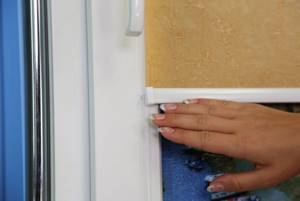
Due to gaps in window frames, significant heat loss can occur
It is difficult to identify places of blowing visually, so their presence is checked in several ways. A wet hand or a lit candle is brought to the window. Wet skin is very sensitive and will immediately feel the slightest air currents, and the flame will fluctuate under the influence of a draft. Windows in good condition need to be insulated around the perimeter, but for heavily damaged structures, all cold bridges must be removed.
You will see how to properly insulate wooden window frames in this video:
How to insulate wooden frames
Wooden window structures are usually insulated using:
Modern profile seal
Window seal profiles
This material is sold in any hardware store and is a tape, with or without an adhesive layer. This seal is also called a tubular profile and is made of the following materials:
- foam rubber
- rubber
- polyvinyl chloride;
- polyethylene foam;
- polyurethane
More popular are adhesive-based seals. But their downside is that they cannot stick as reliably as their self-adhesive counterparts.
The foam seal absorbs moisture, so it must be replaced annually. The polymer tape does not care about water, which significantly increases its service life.
The seal is easy to use: the tape is glued to the open sash around the perimeter, inside and outside. To eliminate particularly large gaps, you can additionally use masking tape.
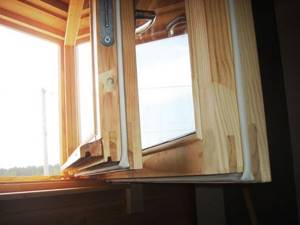
The seal for a wooden window is attached around the perimeter of the frame
To glue a seal without an adhesive base, it is best to use a transparent silicone adhesive-sealant.
Available means
The method is suitable for insulating old wooden windows for the winter, as it is designed to eliminate too large gaps. They can be filled with cotton wool, rags, paper or foam rubber. A special putty for wood will also work.
Warming stages:
- firmly tamp the cotton wool or other material into the cracks using, for example, a wide screwdriver;
- Glue strips of fabric or paper over the material.
Glue for these purposes can be made from a soap solution or two components - water and starch. The recipe is simple: pour a heaping tablespoon of starch into one 200 ml glass of water, bring to a boil, stirring constantly.
Instead of starch, you can use sifted flour. After cooling the paste, proceed to insulation.
Paraffin
Paraffin can be purchased at any hardware store.
This method was widespread several decades ago among housewives who knew exactly how to insulate wooden windows for the winter, as it made it possible to seal large cracks quickly and at no cost.
The paraffin candle must be melted in a water bath and the hot mixture must be poured into a preheated syringe. Using this device you need to quickly process all the gaps.
Putties
Insulating windows for the winter with special mixtures or something similar with your own hands is an effective, but radical method. Removing such insulation often damages the paint, so this method is suitable for old windows that you plan to replace soon.
Adhesive putties, a 1:1 solution of alabaster and chalk, and special sealants for window seams are suitable as insulation. The mixture is applied to the gaps, leveled with a spatula and left until completely dry.
Heat-saving film
Heat-saving film is an effective way to avoid heat loss
This method is suitable for insulating wooden window structures and PVC windows.
In hardware stores you can find a special protective film that has universal properties - in summer it protects the room from sunlight, and in winter it increases the temperature by up to 5 degrees.
The material of the required size is glued to the frame beads using double-sided tape and blown with air from a hair dryer to level it and make it transparent.
Additional cold bridges
Be sure to check the lintels above the windows, as they are often where heat leaks. The lintels are insulated from the outside using alternate application of façade polystyrene foam, reinforcing mixture and plaster.
Slopes can also become conductors of cold. For thermal insulation, the side surfaces are sanded, then primed and PVC panels are installed. If voids have formed inside, you need to fill them with tow or polyurethane foam.
A window sill that has been improperly treated with foam is insulated by attaching a piece of PVC panel under it, adjusted to size. The voids are filled with the same materials as in the case of slopes.
How to insulate plastic windows for the winter
To quickly insulate plastic windows for the winter with your own hands, you must first determine the places from which it blows. Only after this can you choose materials and insulation method.
How to determine where it is blowing from a plastic window
You can find places in a plastic structure where the air is blowing from in the following ways:
- By hand. If you run your palm over the surface of the window, you can immediately detect cracks.
- Using a lighter. Fire has a high level of sensitivity to drafts, so even a slight blowing will show.
- Paper. Open the doors, insert a sheet between them and the frame, and close them back. Lightly pull the corner. If the paper pulls out easily, there is a problem with the seal.
Gaps in PVC windows appear for many reasons:
- Poorly executed installation.
- Shrinkage of the house, as a result of which the frame becomes skewed. This phenomenon is typical for new buildings or wooden buildings.
- Saving. Very often the price is reduced at the expense of quality.
- Seal wear.
- Ignoring the rules for operating windows.
Do plastic windows need to be insulated?
Regardless of the reason, the cracks will have to be eliminated in any case. How can you seal or insulate plastic windows to stop it from blowing? There are several options:
- First of all, you need to take care of the slopes, both internal and external. First you need to clean them from dirt, foam residues, etc. Then prime them, seal the cracks with fresh foam, cotton wool or polystyrene foam. Cover the slopes with plasterboard, putty and paint.
- Some details should also be adjusted. Here we mean loops, which are to some extent responsible for the tightness of the seal. To do this you will need a hex screwdriver.
- In some cases, it may be necessary to completely replace the seal. This is a very labor-intensive process that requires dismantling the glazing bead, lining and the glass unit itself. After installing the new seal, all elements are mounted back.
How to insulate plastic windows to prevent sweating? You can use heat-saving film, which is glued directly to the glass, install a glass heating system, hang warm curtains or fabric (woolen) blinds.
Tips for choosing
As a rule, a tape is selected based on three indicators.
By material
- Foam rubber has been used for insulation since ancient times. Currently it is included in the tape.
Main advantages:
low cost;
high elasticity, allowing you to close gaps of different sizes.
There are also disadvantages:
Due to the porous structure, moisture is quickly absorbed. The drying process takes a very long time;
low durability. With prolonged use, the material turns yellow and crumbles.
- Polyvinyl chloride (PVC) is a material with high strength and adhesiveness. It is not afraid of humidity and temperature fluctuations. The tapes are fixed on any surface and stretch well.
Unfortunately, such tapes are rarely used for window insulation, as they increase the cost of window construction by up to 15%.
- Rubber - used to make two types of tapes: self-adhesive and sealing.
Tubular seals with groove
Self-adhesive tapes are made on the basis of synthetic rubber and have all its positive qualities: elasticity and resistance to temperature fluctuations.
Rubber seals are not afraid of aggressive environments, so they last a very long time.
- Polyurethane foam (PPE) is a porous material made of foamed polyethylene.
Due to their high elasticity, the tapes are very effective for small gaps. Good insulating qualities. Due to the presence of air in the structure, a thermal insulating environment is created.
Its use is limited by its ability to transform into a toxic liquid state at high temperatures.
By manufacturer
In construction stores you can find tapes from different manufacturers.
However, only materials from the following brands are in demand:
Russia - Profitrast, Economy, Zubr.
Germany - KIMTEC, Deventer.
Poland - Sanok.
Domestic manufacturers, as a rule, work using European technologies and produce high-quality material no worse than foreign samples. At the same time, German and Polish ribbons, although more expensive, last longer.


